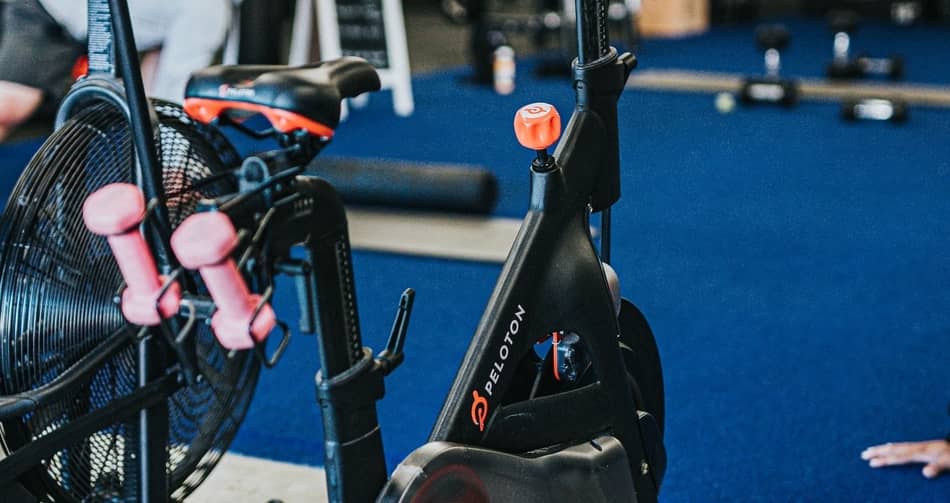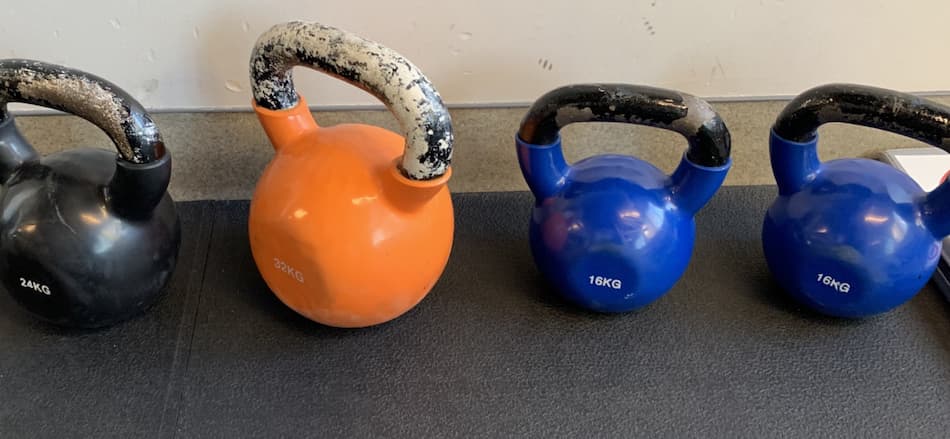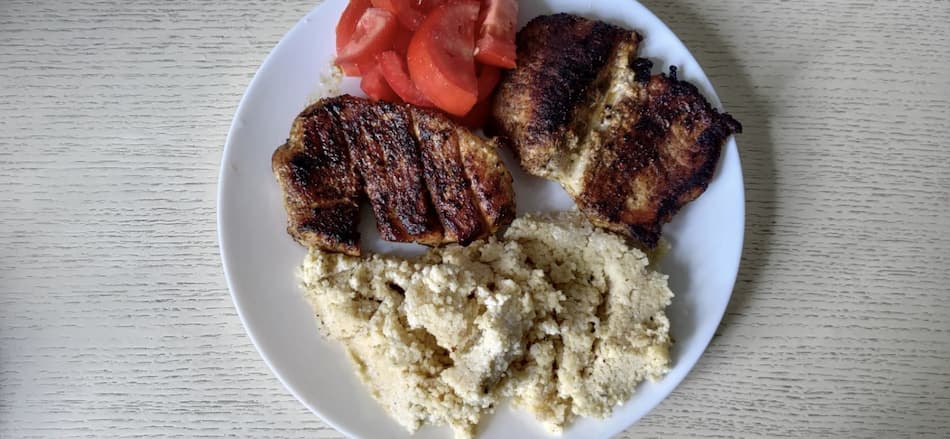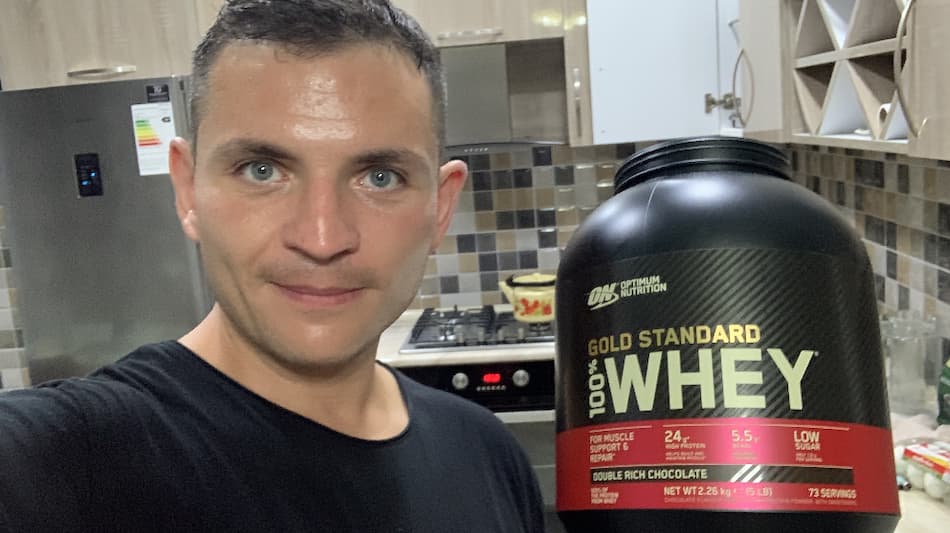Peloton is a great fitness-at-home solution not only for the spinning enthusiast but also for everyone who wants to get fit and is looking for a great strength training workout.
Today I will explain if can you build muscle with a peloton, and if so, which classes should you take.

In general, the peloton does build muscle because it offers a range of floor workouts that uses weights, resistance bands, and bodyweight exercises. However, for optimal hypertrophy, you need to choose classes that are focused on the same muscle group (e.g. Upper Body Strength) to reach muscular failure.
I will also touch on the how peloton builds muscles in your legs and which workouts you should be looking at.
Peloton does build muscle
Let me start by saying that most people I know use the peloton bike purely for their cycling classes. However, if you wanna build muscle, you cannot do it just by riding the bike.
Apart from their bike workouts, they also have many strength training classes (both live and on-demand).
Plus, the company recently released “peloton Guide”, which is a smart device with innovative camera technology that tracks your form and monitors your workouts.
Peloton is not like a regular gym
Of course, the most effective way to bulk up on muscle mass is to get your ass to the gym and lift heavy weights. There is a big difference between the peloton and gym, especially when it comes to hypertrophy.
(Hypertrophy is a fancy name to describe muscle process. It occurs after a muscle has been under stimuli of heavy load, usually from lifting weights).
For example.
- Some of the peloton bike classes use high resistance, but it’s still a cardio workout, not a typical weight lifting session).
- Peloton strength classes are almost all circuit-training style workouts. These workouts do work your muscles and increase your heart rate but are not the most effective in hypertrophy.
If we gonna take one step further, current resistance training guidelines from ACSM recommend using 70-90% of 1RM (1 repetition maximum) to maximize adaptations in muscle strength and hypertrophy.
This means that if you want to get a chiseled body, you need to choose weights that are heavy and challenging.
Peloton does not use heavy weights
Unfortunately, there are no peloton classes where you can lift heavy weights such as barbells. From what I have seen so far, the weight of peloton dumbbells for bike ranges from 1-3 lbs.
In strength classes, some instructors use weights up to 30 lbs.
For my strength classes, I bought a set of dumbbells and kettlebells that range from 20 to 50 lbs, so I can alternate between them, depending on the exercise.

Of course, if you’re using the standard 10-30 lbs weights, this does not mean you cannot get stronger and build muscle (you can). It will only take more time, compared to heavy resistance training.
- On the one hand, many experts, including Brad Schoenfeld, PhD., recommend using a lower rep range (1-5RM) for optimal strength and a medium rep range (8-12 RM) for hypertrophy.
- On the other hand, Dr. Schoenfeld also admits that muscle hypertrophy can be equally achieved across a spectrum of loading ranges.
- According to Dr. Schoenfeld, low-load resistance training was equally effective as high-load resistance training in improving isometric strength, isokinetic strength, lean body mass, and hypertrophy
Long story short, you can build muscle with a peloton, but it will require a specific type of training (more on that later).
What muscles does the peloton work?
In general, the peloton works almost all the muscles in the body because it offers a variety of classes.
- Peloton bike is just one of the options that work on your legs and core.
- Peloton strength, yoga, or pilates classes work on your upper body as well.
Here you can see the full breakdown of muscles works in the peloton.

| Muscle | When it works |
|---|---|
| Quadriceps | Quads work all the time during the peloton class, however the most impact you can feel in the seated climb sessions and sprint. |
| Hamstrings | Hamstrings are the antagonists of quads so they work all the time, but the most effective way to work them is by changing the positions from seated to standing. |
| Glutes | Glutes work the most when you’re standing |
| Hip flexors | Hip flexors work the most during the standing positions |
| Calves | Calves are most engaged during standing |
| Core | Core works throughout the session and you need to keep it tight all the time |
Also, many peloton bike classes offer sessions where the instructor is using the weights. During the session, you simply stop pedaling to grab a weight and do some upper body movements.
This is a great way to engage upper body muscles and push the blood towards them.
This way it keeps the balance.
Does peloton work your whole body?
Generally, the peloton does work your whole body because it offers a variety of sessions that engage the upper and lower body.
Peloton bike and thread work on your legs and core, whereas peloton strength, HIIT, and Bootcamp work on arms, shoulders, and chest.
Here is the breakdown of the classes and what muscles they work.
| Class | Body parts |
|---|---|
| Strength | Full body (using weights) |
| Running | Lower body and core |
| Yoga | Full body (flexibility, balance, and strength) |
| Bike bootcamp | Full body (cycling and weights) |
| Tread bootcamp | Full body (running and weights) |
| Pilates | Full body (no equipment) |
Best peloton classes to build muscle
The peloton offers several types of resistance training workouts:
- Strength
- Cardio HIIT
- Tabata
- Bootcamp
- Rowing (I mention rowing because I believe peloton rower is coming soon).
On top of that, each type of class has a bunch of sub-categories.
For example, the strength class has in total of almost 5,000 workouts and is further divided into 14 different categories.
- Bodyweight
- Full Body
- Core
- Upper Body
- Lower Body
- Strength For Runners
- Resistance Bands
- Adaptive
- Pilates
- Boxing Bootcamp

(Let me be clear, I haven’t tried them all. It would take me over 13 years to complete all peloton strength classes).
What I know is that some workouts are better than others.
The best peloton classes to build muscle are the upper and lower body from the strength category. These workouts focus on one muscle group per class, which is essential to stimulate metabolic stress, and muscle growth, especially if you’re using lighter weights.
Classes like full body, core, and boxing bootcamp are also effective, but they use circuit-style training protocol that challenges your cardiorespiratory fitness.
You need muscle failure
Most of the classes use low weights (less than 60% of 1 repetition maximum), so the only way to stimulate muscle growth is by applying high training volume (training to muscular failure).
When I say muscle failure I mean doing exercise to the point where a muscle can no longer contract concentrically.
For example.
- It’s the moment where you can do 10 reps of pushups, but you don’t have enough strength to do 11.
- The muscle becasue tired and “refuse” to perform another rep (It’s this uncomfortable moment where you have to push your body).
- Full-body workouts where don’t train until muscle failure. These types of classes are great for elevating your heart rate and burning calories, not for hypertrophy.
- On the other hand, “split training” classes work around one muscle group (e.g. chest and shoulders). These workouts are usually shorter, yet very effective.
That’s what you want.
Some of the best peloton strength classes train the same muscle group in one class. This allows you to apply enough training volume (total number of reps) so that you can reach muscle failure multiple times per class.
Cool, right?
How to build muscle with peloton
The best way to build muscle and get stronger with the peloton is to combine multiple strength and cardio workouts.
Focus on body parts
To build muscle with the peloton you need to focus on the classes that target one specific body part (e.g. Arms and Shoulders).
These classes use high training volume and are effective to induce metabolic stress.
Combine two classes in one session
- For the upper body, you can combine a full-body workout with split training classes to maximize muscle hypertrophy.
- Start with a full-body workout and follow up with a split training class.
- For the lower body, combine strength classes with cycling classes.
Use different cycling classes
Muscles in the legs are made of different types of muscle fibers – fast twitch and slow twitch.
- Fast twitch is easier to grow, but they are also more difficult to train (you can think of HIIT workouts).
- Slow-twitch muscle fibers are for endurance. They’re easier to train but harder to grow.
Use cycling workouts that target both fast and slow-twitch muscle fibers. This means you want to have a good mix of intervals and endurance rides.
- For example, 15 min HIIT ride together with a Power Zone Endurance ride.
- Alternate between high resistance (climb rides) and low resistance (low impact rides).
For example.
- Slow-twitch muscle fibers require a lower training load but high training volume for hypertrophy.
- On the other hand, fast-twitch muscle fibers require high resistance, but lower training volume (more on that later).
Use HIIT workouts
- Use high-intensity interval sessions, which require constant shifts from seated sprints to brutal uphill climbs which build strength and muscle.
Those type of classes makes your thighs burn. Within the 20-30 minutes class, you want at least 3-4 tunes that have a slower cadence (I like the range between 80-100 BPM).
Take classes with a slower cadence
- Use slower cadence (cadence in the peloton refers to speed or revolutions per minute).
- Revolutions per minute mean how many times the pedal rotates 360 degrees within one minute time. Music tracks with slow cadence usually have a slower beat.
Beat per minute (BPM) refers to the tempo of the music from the playlist.
- Songs that have low BPM are usually required to stay in the saddle and climb uphill at a slow pace and high resistance.
- Tracks that have faster BPM are usually required to stand up and move faster with lower resistance.
Cadence is important for building muscle because the lower the cadence, the more resistance you put on.
Use high resistance
Adding more resistance fires up the type 2 muscle fibers and keeps your quadriceps working hard. In some classes, the instructor will ask you to stay seated in the “saddle”.
For me, this is the most difficult part. I think that seated classes are the most challenging because you cannot move around.
I like to use high resistance becasue helps to build my endurance, increases my heart rate, and burns more calories in general. However, I always stand on the bike. Sitting is brutal.
Challenge yourself
I know it may sounds cliche, but to grow the muscle with the peloton, you need to systematically challenge your body (progressive overload).
This means adding more training volume, duration, or workout frequency over time. This also means using heavier dumbbells.
Studies have shown that “progressive mechanical tension overload is considered one of the major factors of muscle growth and changes in muscle”, regardless of the training load (Peterson et al. 2011).
- Increase exercise frequency to 3-5 times per week (low-load resistance training requires high training frequency to build muscle).
Eat more protein
Apart from strength training, your daily protein intake also matters. I recommend getting somewhere between 130 to 200 grams of protein per day, depending on your body weight.

As you can see, I don’t have any problems with eating more proteins during the day. I like to eat meat, and eggs and drink protein powder.
If you don’t like to eat more meat, one way to up your protein levels is to supplement with whey protein powder.

Eat less and move more
A calorie deficit is important with a peloton because it allows you to burn more fat and get lean. Creating a calorie deficit with a peloton is easier than ever because you have access to daily high-intensity exercise at your fingertips.
You can learn more about how to combine nutrition with the peloton in my article “peloton and diet“.
Peloton does build leg muscle
When you think about it, professional cyclists have much larger leg muscles compared to other parts of the body. This means that cycling is the best way to build leg muscle, right?
Not so fast.
Generally, the peloton does build leg muscle, however, it requires a longer period to significantly increase muscle size compared to typical resistance training.
Plus, studies have shown that cycling at higher intensity is required to achieve optimal strength and hypertrophy gains.
Research
- Some of the leg muscles consist of up to 70% of slow-twitch muscle fibers (Edgerton et al. 1975).
- Slow-twitch muscle fibers (also called oxidative muscle fibers) require higher training volume with lower training load to induce hypertrophy.
- However, these muscle fibers accumulate significantly more metabolites and free radicals (compared to fast-twitch muscle fibers).
- High accumulation of reactive oxygen species accelerates muscle protein breakdown. Once the protein degradation levels with protein synthesis, the chances for hypertrophy are slim (Grgic, 2018).
Do you get what I mean? Higher training volume can speed up the process of breaking down muscle. This makes it very difficult to build muscles in the legs.
Peloton does not make legs bigger
In general, a peloton won’t make your legs bigger because there is not enough volume to trigger hypertrophy.
Doing 20 minutes of class, even for 7 days a week, will develop muscle endurance and stamina, but it won’t make the legs big, as long as you control your calorie intake.
It is possible to gain weight after a peloton, but it’s not due to exercise, but higher food intake.
- People who do peloton classes and get bigger legs don’t do so because of the resistance or the volume.
- Nutrition plays a role here too. Eating high-carb meals after the workouts to “reward” yourself for a tough session over time can lead to bigger legs.
The high-intensity classes lead to high energy expenditure and greater appetite after a workout. If your goal is better performance then there is no problem. You can eat and do the peloton as much as you want.
But if your goal is better body composition, together with doing classes you need to look at your nutrition.
Building muscle vs gaining weight
When I build muscle, I don’t want to gain fat at the same time. To do so, I need to watch what I eat.
The easy solution is to have more protein-rich and high-fiber foods. Those foods will increase your satiety and lower your appetite.
Some of the best options are:
- Eggs
- Chicken
- Fish
- Beef
Having protein with every single meal not only will help you eat less food, and lower your cravings but also increase energy expenditure.
Proteins are the most “metabolically” expensive nutrients. This means the body needs a lot more energy to break down, digest, and absorb all the amino acids.
In other words, you burn more calories just by eating more proteins.
On the other hand, eating high-carb meals will give you those spikes in blood sugar, fluctuations in energy levels, and an increased appetite for more food. So even if you’re doing a great job on the peloton bike, because of more calorie intake, the legs get bigger.
You can get ripped
In general, you can get ripped using a peloton, as long as you’re in a calorie deficit.
The high-intensity peloton classes allow for regular cardio workouts, and with a combination of low-calorie and high-protein diets, you can lose fat and build muscle at the same time.
Getting ripped with a peloton is more about nutrition than exercise, to be honest.
You can still do your 20 minutes daily classes, but if you don’t follow up with the diet that creates a calorie deficit, then it won’t work.
Conclusion
Building muscle on the peloton is fun and the best way to do it is by joining the classes that are doing climbing and HIIT.
One of my favorite peloton instructors that is doing a lot of HIIT and climb combinations is Olivia Amato. her classes are tough with limited rest. That’s when you build up your leg muscles.
Of course, please keep in mind that building muscle with a peloton is not the same as building muscle in the gym.
